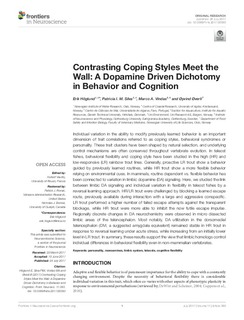| dc.contributor.author | Höglund, Erik | |
| dc.contributor.author | Silva, Patricia IM | |
| dc.contributor.author | Vindas, Marco Antonio | |
| dc.contributor.author | Øverli, Øyvind | |
| dc.date.accessioned | 2018-03-23T12:17:45Z | |
| dc.date.available | 2018-03-23T12:17:45Z | |
| dc.date.created | 2017-09-28T10:05:07Z | |
| dc.date.issued | 2017 | |
| dc.identifier.citation | Frontiers in Neuroscience. 2017, 11, 7, 383. | nb_NO |
| dc.identifier.issn | 1662-4548 | |
| dc.identifier.uri | http://hdl.handle.net/11250/2491926 | |
| dc.description.abstract | Individual variation in the ability to modify previously learned behavior is an important dimension of trait correlations referred to as coping styles, behavioral syndromes or personality. These trait clusters have been shaped by natural selection, and underlying control mechanisms are often conserved throughout vertebrate evolution. In teleost fishes, behavioral flexibility and coping style have been studied in the high (HR) and low-responsive (LR) rainbow trout lines. Generally, proactive LR trout show a behavior guided by previously learned routines, while HR trout show a more flexible behavior relying on environmental cues. In mammals, routine dependent vs. flexible behavior has been connected to variation in limbic dopamine (DA) signaling. Here, we studied the link between limbic DA signaling and individual variation in flexibility in teleost fishes by a reversal learning approach. HR/LR trout were challenged by blocking a learned escape route, previously available during interaction with a large and aggressive conspecific. LR trout performed a higher number of failed escape attempts against the transparent blockage, while HR trout were more able to inhibit the now futile escape impulse. Regionally discrete changes in DA neurochemistry were observed in micro dissected limbic areas of the telencephalon. Most notably, DA utilization in the dorsomedial telencephalon (DM, a suggested amygdala equivalent) remained stable in HR trout in response to reversal learning under acute stress, while increasing from an initially lower level in LR trout. In summary, these results support the view that limbic homologs control individual differences in behavioral flexibility even in non-mammalian vertebrates. | nb_NO |
| dc.language.iso | eng | nb_NO |
| dc.publisher | Frontiers Media | nb_NO |
| dc.rights | Navngivelse 4.0 Internasjonal | * |
| dc.rights.uri | http://creativecommons.org/licenses/by/4.0/deed.no | * |
| dc.title | Contrasting Coping Styles Meet the Wall: A Dopamine Driven Dichotomy in Behavior and Cognition | nb_NO |
| dc.type | Journal article | nb_NO |
| dc.type | Peer reviewed | nb_NO |
| dc.description.version | publishedVersion | nb_NO |
| dc.rights.holder | Copyright © 2017 Höglund, Silva, Vindas and Øverli | nb_NO |
| dc.source.pagenumber | 7 | nb_NO |
| dc.source.volume | 11 | nb_NO |
| dc.source.journal | Frontiers in Neuroscience | nb_NO |
| dc.identifier.doi | 10.3389/fnins.2017.00383 | |
| dc.identifier.cristin | 1499411 | |
| dc.relation.project | EC/H2020/60477 | nb_NO |
| dc.relation.project | Fundação para a Ciência e Tecnologia: SFRH/BD/44103/2008 | nb_NO |
| cristin.unitcode | 7464,20,15,0 | |
| cristin.unitname | Akvakultur | |
| cristin.ispublished | true | |
| cristin.fulltext | original | |
| cristin.qualitycode | 1 | |

